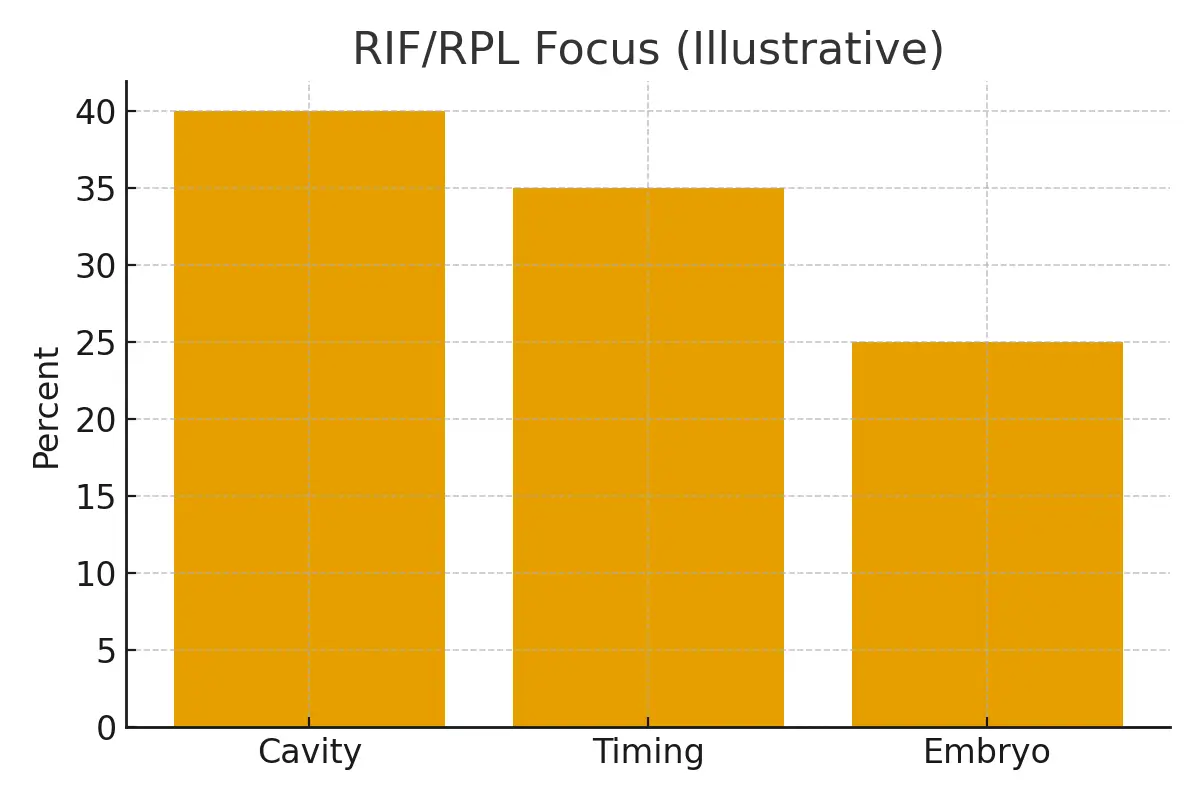
This guide explains what recurrent implantation failure (RIF) means within the Uterine & Implantation (RIF/RPL) pathway. It focuses on choices that truly change outcomes, budgets, and timelines—so you can move forward with confidence instead of confusion.
What It Is
Recurrent Implantation Failure (RIF) is when multiple good-quality embryos are transferred but do not implant successfully. In plain English: it’s about when the uterus and embryo aren’t “connecting” as expected, despite having what looks like a good chance on paper.
Who It Helps
This pathway is helpful if you:
- Have had two or more failed embryo transfers.
- Are over 35 and want to understand how age affects outcomes.
- Have unexplained negative results despite normal labs and imaging.
- Need clarity on whether the issue is embryo quality, uterine environment, or timing.
It may not be the best path if your history points clearly to another cause (such as severe male factor infertility or genetic mismatch).
Step-by-Step
- Confirm definition – review number of transfers and embryo quality.
- Evaluate uterus – imaging, hysteroscopy, and cavity assessment.
- Check labs – hormones, clotting, thyroid, immune-related factors.
- Assess embryos – genetic testing, lab conditions, transfer method.
- Optimize timing & support – luteal phase, protocol alignment, medication.
Each step has timing checkpoints to protect embryo quality and reduce stress.
Pros & Cons
Pros
- Pinpoints whether to adjust embryo strategy, uterine treatment, or both.
- Provides structured checkpoints, reducing wasted cycles.
- Helps balance cost and emotional energy with evidence-based choices.
Cons
- Testing can be expensive and time-consuming.
- Some findings may not have proven treatments.
- Emotional burden if results remain unexplained.
Costs & Logistics
- Line items: imaging, genetic testing, hysteroscopy, medications.
- Insurance: may require prior authorizations.
- Budget planning: escrow and cash-flow tracking prevent surprise bills.
- Logistics: pharmacy timelines, clinic calendar, hospital coordination.
What Improves Outcomes
- Uterine cavity evaluation – rules out scarring or polyps.
- Genetic testing of embryos (PGT-A) – reduces transfer of non-viable embryos.
- Protocol timing & luteal support – improves synchronization.
- Lab quality & communication – ensures consistent embryo handling.
- Mental health support – lowers stress, improves resilience during cycles.
Case Study
A 38-year-old patient with three failed transfers underwent a structured RIF work-up. Imaging found a small uterine adhesion; embryos were also tested with PGT-A. After correction and transfer of a chromosomally normal embryo, pregnancy was achieved. Key takeaway: defined checkpoints + clear communication = clarity and progress.
Mistakes to Avoid
- Skipping uterine cavity evaluation.
- Assuming all embryos are equal quality.
- Over-treating without evidence.
- Not clarifying costs upfront.
- Ignoring emotional health.
FAQs
Q. How many failed transfers count as RIF?
Ans : Generally, RIF is considered after two or more failed transfers of good-quality embryos.
Q. Could the problem be the embryo and not my uterus?
Ans : Yes. Sometimes embryos look healthy under the microscope but carry genetic issues. PGT-A testing can help clarify.
Q. Are there proven treatments for RIF?
Ans : Some interventions (like hysteroscopy or correcting hormone levels) clearly help. Others (like immune therapies) have limited evidence. Your doctor should explain what is proven vs. experimental.
Q. How much does a full RIF evaluation cost?
Ans : It varies, but expect costs for imaging ($500–$2,000), genetic testing ($2,000+ per cycle), and possible surgical procedures. Insurance coverage differs widely.
Q. Will taking a break between transfers improve my chances?
Ans : Sometimes, yes. Pausing to optimize health, reduce stress, and complete evaluations can improve cumulative success.
Next Steps
- Free 15-minute nurse consult
- Upload your labs for review
- Request a cost breakdown tailored to your case
Related Links

Dr. Kulsoom Baloch
Dr. Kulsoom Baloch is a dedicated donor coordinator at Egg Donors, leveraging her extensive background in medicine and public health. She holds an MBBS from Ziauddin University, Pakistan, and an MPH from Hofstra University, New York. With three years of clinical experience at prominent hospitals in Karachi, Pakistan, Dr. Baloch has honed her skills in patient care and medical research.





